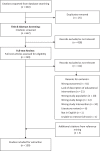Medical education interventions influencing physician distribution into underserved communities: a scoping review
- PMID: 35392954
- PMCID: PMC8991572
- DOI: 10.1186/s12960-022-00726-z
Medical education interventions influencing physician distribution into underserved communities: a scoping review
Abstract
Background and objective: Physician maldistribution is a global problem that hinders patients' abilities to access healthcare services. Medical education presents an opportunity to influence physicians towards meeting the healthcare needs of underserved communities when establishing their practice. Understanding the impact of educational interventions designed to offset physician maldistribution is crucial to informing health human resource strategies aimed at ensuring that the disposition of the physician workforce best serves the diverse needs of all patients and communities.
Methods: A scoping review was conducted using a six-stage framework to help map current evidence on educational interventions designed to influence physicians' decisions or intention to establish practice in underserved areas. A search strategy was developed and used to conduct database searches. Data were synthesized according to the types of interventions and the location in the medical education professional development trajectory, that influence physician intention or decision for rural and underserved practice locations.
Results: There were 130 articles included in the review, categorized according to four categories: preferential admissions criteria, undergraduate training in underserved areas, postgraduate training in underserved areas, and financial incentives. A fifth category was constructed to reflect initiatives comprised of various combinations of these four interventions. Most studies demonstrated a positive impact on practice location, suggesting that selecting students from underserved or rural areas, requiring them to attend rural campuses, and/or participate in rural clerkships or rotations are influential in distributing physicians in underserved or rural locations. However, these studies may be confounded by various factors including rural origin, pre-existing interest in rural practice, and lifestyle. Articles also had various limitations including self-selection bias, and a lack of standard definition for underservedness.
Conclusions: Various educational interventions can influence physician practice location: preferential admissions criteria, rural experiences during undergraduate and postgraduate medical training, and financial incentives. Educators and policymakers should consider the social identity, preferences, and motivations of aspiring physicians as they have considerable impact on the effectiveness of education initiatives designed to influence physician distribution in underserved locations.
Keywords: Graduate medical education; Health Workforce; Medical education; Practice location; Selection criteria; Undergraduate medical education.
© 2022. The Author(s).
Conflict of interest statement
The authors declare that they have no competing interests.
Figures
Similar articles
-
Beyond the black stump: rapid reviews of health research issues affecting regional, rural and remote Australia.Med J Aust. 2020 Dec;213 Suppl 11:S3-S32.e1. doi: 10.5694/mja2.50881. Med J Aust. 2020. PMID: 33314144
-
Associations between education policies and the geographic disposition of family physicians: a retrospective observational study of McMaster University education data.Adv Health Sci Educ Theory Pract. 2024 May;29(2):641-657. doi: 10.1007/s10459-023-10273-4. Epub 2023 Aug 15. Adv Health Sci Educ Theory Pract. 2024. PMID: 37581856
-
Building a sustainable rural physician workforce.Med J Aust. 2021 Jul;215 Suppl 1:S5-S33. doi: 10.5694/mja2.51122. Med J Aust. 2021. PMID: 34218436
-
A scoping review of the association between rural medical education and rural practice location.Hum Resour Health. 2015 May 6;13:27. doi: 10.1186/s12960-015-0017-3. Hum Resour Health. 2015. PMID: 25943870 Free PMC article.
-
Successes, challenges and needs regarding rural health medical education in continental Central America: a literature review and narrative synthesis.Rural Remote Health. 2015 Jul-Sep;15(3):3361. Epub 2015 Sep 25. Rural Remote Health. 2015. PMID: 26402719 Review.
Cited by
-
Equity of access in rural and metropolitan dementia diagnosis, management, and care experiences: an exploratory qualitative study.Int J Equity Health. 2025 Mar 17;24(1):74. doi: 10.1186/s12939-025-02434-1. Int J Equity Health. 2025. PMID: 40091013 Free PMC article.
-
Medical student intentions to practice internal medicine in underserved areas associated with debt, identity and extracurricular participation.BMC Med Educ. 2023 Jun 8;23(1):420. doi: 10.1186/s12909-023-04392-0. BMC Med Educ. 2023. PMID: 37286995 Free PMC article.
-
Provider survey of the roles of clinical pharmacists in primary care in a Federally Qualified Health Center versus an Accountable Care Organization.Explor Res Clin Soc Pharm. 2023 Mar 21;9:100242. doi: 10.1016/j.rcsop.2023.100242. eCollection 2023 Mar. Explor Res Clin Soc Pharm. 2023. PMID: 37008897 Free PMC article.
-
Growing a rural family physician workforce: The contributions of rural background and rural place of residency training.Health Serv Res. 2024 Feb;59(1):e14168. doi: 10.1111/1475-6773.14168. Epub 2023 May 9. Health Serv Res. 2024. PMID: 37161614 Free PMC article.
-
The neighborhood walk: introducing first-year medical students to social determinants of health in underserved neighborhoods.BMC Med Educ. 2025 Jan 31;25(1):163. doi: 10.1186/s12909-025-06743-5. BMC Med Educ. 2025. PMID: 39891170 Free PMC article.
References
-
- World Health Organization. Increasing access to health workers in remote and rural areas through improved retention: global policy recommendations. World Health Organization. 2010. https://apps.who.int/iris/handle/10665/44369. Accessed 17 Dec 2021. - PubMed
-
- Pitblado R. Geographical distribution of rural health human resources. Vancouver: UBC Press; 2012.
-
- StatsCan. Access to a regular medical doctor, 2014: Statistics Canada; 2014. http://www.statcan.gc.ca/pub/82-625-x/2015001/article/14177-eng.htm. Accessed 17 Dec 2021.
-
- Mitton C, Dionne F, Masucci L, Wong S, Law S. Innovations in health service organization and delivery in northern rural and remote regions: a review of the literature. Int J Circumpolar Health. 2011;70(5):460–472. - PubMed
Publication types
MeSH terms
LinkOut - more resources
Full Text Sources
Medical


